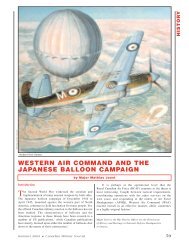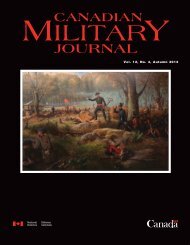MILITARY
CA JOURNAL - Revue militaire canadienne
CA JOURNAL - Revue militaire canadienne
- No tags were found...
Create successful ePaper yourself
Turn your PDF publications into a flip-book with our unique Google optimized e-Paper software.
of many, rapidly shifting priorities destroys the credibility of the<br />
organization and undercuts the credibility of any change efforts. 37<br />
Leadership and Mission Command<br />
The commander is the central figure in mission command 38<br />
and span of control directly affects his or her ability to<br />
communicate effectively with subordinates. Commanders of<br />
smaller organizations typically have more direct power and<br />
influence than in larger organizations because leadership is<br />
not diffused through layers of management. In smaller<br />
organizations, subordinates easily recognize commanders<br />
and constantly observe their behaviour. Therefore,<br />
commanders in smaller organizations possess a strong<br />
potential to establish high ethical standards for all decisions.<br />
Joint commanders whose organizations operate in<br />
unfamiliar or foreign landscapes may need to adjust<br />
ethical standards or expectations. If the commander fails<br />
to provide the proper environmental and ethical guidance,<br />
some personnel may engage in ‘rogue’ behaviour<br />
in an attempt to achieve their objectives. In other words,<br />
some personnel may fail to distinguish when crossing<br />
the line of good judgment and commit unethical acts<br />
when attempting to navigate their way through unfamiliar<br />
environments. 39 With that mind, leaders throughout<br />
the organization must espouse, and, more important,<br />
model ethical behaviour. 40<br />
In mission command, values must not be abstract and<br />
theoretical—they must be acted upon. To achieve organizational<br />
goals, commanders must first communicate the desired outcomes<br />
to their subordinates and develop behavioral expectations to<br />
achieve those outcomes. Once identified and taught, subordinates<br />
must live by those expectations, and commanders must constructively<br />
confront those who violate them (Figure 3). Culture is<br />
ultimately defined by what commanders expect and what commanders<br />
tolerate. 41 Trust in commanders is extremely important<br />
for the Joint Force as missions and tasks are highly complex,<br />
and they routinely call for high levels of interdependence and<br />
cooperation. Ultimately a reflection of values, trust is on display<br />
for all to see and judge. 42<br />
Leadership <br />
Intent <br />
Understanding <br />
Trust <br />
Ethics <br />
Trust <br />
Trust <br />
Mission Command <br />
Ethics <br />
Values <br />
Trust <br />
Trust <br />
Figure 3: Values, Ethics, and Mission Command<br />
Joint <br />
Force <br />
Success <br />
Credit: DVIDS photo 49876<br />
Credit: Dan McCauley<br />
22 Canadian Military Journal • Vol. 13, No. 4, Autumn 2013





